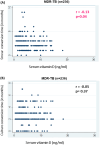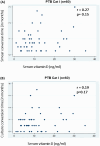Response to treatment and low serum vitamin D levels in North Indian patients with treatment-naive category I and multi-drug resistant pulmonary tuberculosis
- PMID: 39311013
- PMCID: PMC11421155
- DOI: 10.1080/07853890.2024.2407066
Response to treatment and low serum vitamin D levels in North Indian patients with treatment-naive category I and multi-drug resistant pulmonary tuberculosis
Abstract
Background: Tuberculosis (TB) is a bacterial infection that usually affects the lungs, although it can also affect other parts of the body. Vitamin D deficiency and response to treatment have been demonstrated in patients with active TB in several studies, but not in MDR-TB patients, which is a new observation in the present study.
Objective: To study the time to initial sputum culture conversion and to associate baseline vitamin D levels and response to treatment in patients with PTB Cat I and MDR-TB.
Methods: A total of 897 North Indian participants were recruited and divided into three groups: treatment-naïve PTB Cat I, MDR-TB, and healthy controls. Serum biochemistry, including 25-hydroxyvitamin D and calcium, was measured in all participants with PTB, Cat I, and MDR-TB.
Results: PTB Cat I patients had high bacillary load grading at baseline compared to 2nd month followed by 6th month of treatment. More severe chest radiographic features, such as cavitation and the presence of bilateral disease at baseline. Mean sputum smear conversion times were 0.95 ± 0.7 months and culture conversion to negative occurred at a mean time of 0.8 ± 0.7 in PTB Cat I patients compared to MDR-TB patients on average sputum smear and time of 2.4 ± 3 months. Significantly lower mean serum 25-hyroxyvitamin D concentration was found in the 6th month than in the 2nd month and baseline in PTB Cat I.
Conclusion: Low serum vitamin D deficiency was observed in both groups during treatment and is one of the important factors responsible for susceptibility to TB in both groups; however, its significance is uncertain. Patients with continuous positive sputum for multidrug-resistant tuberculosis (MDR-TB) had a worse prognosis than those with sputum bacteriology conversion. Two months into a treatment regimen, sputum smear conversions may be a useful indicator of an MDR-TB patient's prognosis.
Keywords: Cat I pulmonary tuberculosis; Multi-drug resistant tuberculosis; smear and culture conversion; treatment response; vitamin D.
Conflict of interest statement
The authors have disclosed no financial interests or conflicts of interest.
Figures






References
-
- Global Tuberculosis Report 2022 [Internet] . [cited 2024 Jan 18]. Available from: https://www.who.int/teams/global-tuberculosis-programme/tb-reports/globa...
-
- Barilar I, Battaglia S, Borroni E, The CRyPTIC Consortium ., et al. Quantitative measurement of antibiotic resistance in Mycobacterium tuberculosis reveals genetic determinants of resistance and susceptibility in a target gene approach. Nat Commun. 2024;15(1):488. doi: 10.1038/s41467-023-44325-5. - DOI - PMC - PubMed
MeSH terms
Substances
LinkOut - more resources
Full Text Sources
Medical
Miscellaneous
